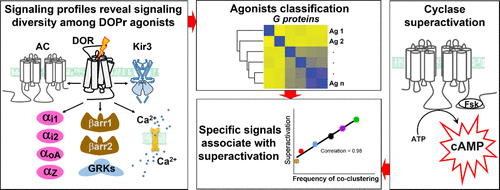当前位置:
X-MOL 学术
›
ACS Pharmacol. Transl. Sci.
›
论文详情
Our official English website, www.x-mol.net, welcomes your
feedback! (Note: you will need to create a separate account there.)
Comprehensive Signaling Profiles Reveal Unsuspected Functional Selectivity of δ-Opioid Receptor Agonists and Allow the Identification of Ligands with the Greatest Potential for Inducing Cyclase Superactivation
ACS Pharmacology & Translational Science ( IF 4.9 ) Pub Date : 2021-09-09 , DOI: 10.1021/acsptsci.1c00019 Ahmed Mansour 1, 2 , Karim Nagi 3 , Paul Dallaire 1, 2 , Viktoriya Lukasheva 4 , Christian Le Gouill 4 , Michel Bouvier 4 , Graciela Pineyro 1, 2
ACS Pharmacology & Translational Science ( IF 4.9 ) Pub Date : 2021-09-09 , DOI: 10.1021/acsptsci.1c00019 Ahmed Mansour 1, 2 , Karim Nagi 3 , Paul Dallaire 1, 2 , Viktoriya Lukasheva 4 , Christian Le Gouill 4 , Michel Bouvier 4 , Graciela Pineyro 1, 2
Affiliation

|
Prolonged exposure to opioid receptor agonists triggers adaptations in the adenylyl cyclase (AC) pathway that lead to enhanced production of cyclic adenosine monophosphate (cAMP) upon withdrawal. This cellular phenomenon contributes to withdrawal symptoms, hyperalgesia and analgesic tolerance that interfere with clinical management of chronic pain syndromes. Since δ-opioid receptors (DOPrs) are a promising target for chronic pain management, we were interested in finding out if cell-based signaling profiles as generated for drug discovery purposes could inform us of the ligand potential to induce sensitization of the cyclase path. For this purpose, signaling of DOPr agonists was monitored at multiple effectors. The resulting signaling profiles revealed marked functional selectivity, particularly for Met-enkephalin (Met-ENK) whose signaling bias profile differed from those of synthetic ligands like SNC-80 and ARM390. Signaling diversity among ligands was systematized by clustering agonists according to similarities in Emax and Log(τ) values for the different responses. The classification process revealed that the similarity in Gα/Gβγ, but not in β-arrestin (βarr), responses was correlated with the potential of Met-ENK, deltorphin II, (d-penicillamine2,5)-enkephalin (DPDPE), ARM390, and SNC-80 to enhance cAMP production, all of which required Ca2+ mobilization to produce this response. Moreover, superactivation by Met-ENK, which was the most-effective Ca2+ mobilizing agonist, required Gαi/o activation, availability of Gβγ subunits at the membrane, and activation of Ca2+ effectors such as calmodulin and protein kinase C (PKC). In contrast, superactivation by (N-(l-tyrosyl)-(3S)-1,2,3,4-tetrahydroisoquinoline-3-carbonyl)-l-phenylalanyl-l-phenylalanine (TIPP), which was set in a distinct category through clustering, required activation of Gαi/o subunits but was independent of the Gβγ dimer and Ca2+ mobilization, relying instead on Src and Raf-1 to induce this cellular adaptation.
中文翻译:

全面的信号分析揭示了 δ-阿片受体激动剂的功能选择性,并允许鉴定最有可能诱导环化酶超活化的配体
长时间暴露于阿片受体激动剂会触发腺苷酸环化酶 (AC) 途径的适应,从而导致戒断时环磷酸腺苷 (cAMP) 的产生增加。这种细胞现象会导致戒断症状、痛觉过敏和镇痛耐受,从而干扰慢性疼痛综合征的临床管理。由于 δ-阿片受体 (DOPrs) 是治疗慢性疼痛的有希望的靶点,因此我们有兴趣了解为药物发现目的而生成的基于细胞的信号传导谱是否可以告知我们配体诱导环化酶路径致敏的潜力。为此目的,在多个效应器上监测 DOPr 激动剂的信号传导。由此产生的信号谱显示了显着的功能选择性,特别是对于 Met-enkephalin (Met-ENK),其信号偏倚分布与 SNC-80 和 ARM390 等合成配体不同。配体之间的信号多样性通过聚类激动剂根据相似性进行系统化不同响应的E max和 Log(τ) 值。分类过程显示,Gα/Gβγ 中的相似性,但与 β-arrestin (βarr) 中的相似性与 Met-ENK、deltorphin II、( d-青霉胺2,5)-脑啡肽 (DPDPE)、ARM390的潜力相关和 SNC-80 来增强 cAMP 的产生,所有这些都需要 Ca 2+动员来产生这种反应。此外,Met-ENK 是最有效的 Ca 2+动员激动剂,其超活化需要 Gαi/o 激活、膜上 Gβγ 亚基的可用性以及钙调蛋白和蛋白激酶 C (PKC ) 等 Ca 2+效应物的激活。 )。相反,通过 ( N -( l-tyrosyl)-(3 S )-1,2,3,4-tetrahydroisoquinoline-3-carbonyl) -l -phenylalanyl - l -phenylalanine (TIPP ),它通过聚类被设置在一个不同的类别中,需要激活 Gαi/ o 亚基,但不依赖于 Gβγ 二聚体和 Ca 2+动员,而是依赖 Src 和 Raf-1 来诱导这种细胞适应。
更新日期:2021-10-08
中文翻译:

全面的信号分析揭示了 δ-阿片受体激动剂的功能选择性,并允许鉴定最有可能诱导环化酶超活化的配体
长时间暴露于阿片受体激动剂会触发腺苷酸环化酶 (AC) 途径的适应,从而导致戒断时环磷酸腺苷 (cAMP) 的产生增加。这种细胞现象会导致戒断症状、痛觉过敏和镇痛耐受,从而干扰慢性疼痛综合征的临床管理。由于 δ-阿片受体 (DOPrs) 是治疗慢性疼痛的有希望的靶点,因此我们有兴趣了解为药物发现目的而生成的基于细胞的信号传导谱是否可以告知我们配体诱导环化酶路径致敏的潜力。为此目的,在多个效应器上监测 DOPr 激动剂的信号传导。由此产生的信号谱显示了显着的功能选择性,特别是对于 Met-enkephalin (Met-ENK),其信号偏倚分布与 SNC-80 和 ARM390 等合成配体不同。配体之间的信号多样性通过聚类激动剂根据相似性进行系统化不同响应的E max和 Log(τ) 值。分类过程显示,Gα/Gβγ 中的相似性,但与 β-arrestin (βarr) 中的相似性与 Met-ENK、deltorphin II、( d-青霉胺2,5)-脑啡肽 (DPDPE)、ARM390的潜力相关和 SNC-80 来增强 cAMP 的产生,所有这些都需要 Ca 2+动员来产生这种反应。此外,Met-ENK 是最有效的 Ca 2+动员激动剂,其超活化需要 Gαi/o 激活、膜上 Gβγ 亚基的可用性以及钙调蛋白和蛋白激酶 C (PKC ) 等 Ca 2+效应物的激活。 )。相反,通过 ( N -( l-tyrosyl)-(3 S )-1,2,3,4-tetrahydroisoquinoline-3-carbonyl) -l -phenylalanyl - l -phenylalanine (TIPP ),它通过聚类被设置在一个不同的类别中,需要激活 Gαi/ o 亚基,但不依赖于 Gβγ 二聚体和 Ca 2+动员,而是依赖 Src 和 Raf-1 来诱导这种细胞适应。











































 京公网安备 11010802027423号
京公网安备 11010802027423号